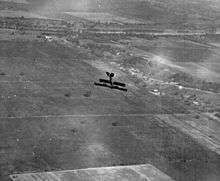Curtiss Flying School
The Curtiss Flying School was started by Glenn Curtiss to compete against the Wright Flying School of the Wright brothers. The first example was located in San Diego, California.[1]


The Wright brothers had a keen interest in their competition, sending the lesser known Lorin Wright to spy and take photographs at the New York facility for a 1914 lawsuit.[2]
Curtiss started the Atlantic Coast Aeronautical Station on a 20-acre tract east of Newport News (VA) Boat Harbor in the Fall of 1915 with Captain Thomas Scott Baldwin as head. Many civilian students, including Canadians, later became World War I flyers. Victor Carlstrom, Vernon Castle, Eddie Stinson and Gen Billy Mitchell trained here. The school was disbanded in 1922.[3]
Students would work toward completing the Aero Club of America pilot's license. The initial cost was one dollar a minute for the four-hundred-minute course ($8,600 in 2010 dollars). In 1917 the U.S. Army took over operations during World War I. After the war, control went back to Curtiss, who closed Newport operations in 1922.[4]
A large variety of aircraft were used for training, mostly designed and built by Curtiss, and still undergoing flight testing. Among the fleet included the first aircraft to take off from water.[5]
By 1929, the Aeronautical Chamber of Commerce took over licensing of aviation schools. Curtiss schools were registered and required to give two weeks of ground school instruction to new pilots.[6]
Locations
- 1910 San Diego, California. Training in the Curtiss Model D.[7][8]
- 1912 Miami, Florida. Two 200 foot by 800 foot airstrips were provided by the city, with funding to ship in four training aircraft.[9] This was the first flying service school, which eventually was donated to a Naval Air Base[10]
- 1913 Hammondsport, New York
- 1915 Toronto, Ontario, Canada Long Branch Aerodrome, Training in the Curtiss JN-3.[11]
- 1915 Newport News, Virginia Harbor. Site of training for the Canadian Royal Flying Corps. Disbanded in 1922.[12][13][14]
- 1918 Camp Claudio, Paranaque, Commonwealth of the Philippines, in training the Philippine Constabulary Air Corps, which became the forerunner of the Philippine Army Air Corps and Philippine Air Force.[15]
- 1929 Stratford, Connecticut Shortly afterword became Curtiss-Wright Flying School. The historic Curtis Hangar still stands. Howard Hughes and Charles Lindbergh once frequented the hangar. Amelia Earhart kept a plane there. It was home to the prototype for the Vought F4U Corsair Lindbergh was a Corsair test pilot.
Instructors
The following were instructors in 1915:[16]
- Walter Edwin Lees
- Victor Carlstrom
- Victor Vernon
- Jimmy Johnson (aviator)
- Carl Batts
- Steve MacGordon
- Ted Hequemburg
- Lawrence Leon
- Bertrand Blanchard Acosta
- Andrew Cogswell
Students
- Fred Banbury (1893-1918) in 1916.
- Lincoln Beachey (1887–1915) in 1910.
- Joseph Bennett (aviator).
- Morris Maxey Titterington (1891–1928) in 1914.[17]
- Harold Frederick Pitcairn (1891-1960) in 1916.
References
- "Glenn H. Curtiss". Glennhcurtissmuseum.org. Archived from the original on 2013-04-14. Retrieved 2014-05-28.
- Fred Howard. Wilbur and Orville A Biography of the Wright Brothers.
- Annual Newsletter, Newport News Historical Committee, 1989.
- John V. Quarstein. World War I on the Virginia Peninsula.
- Edith Dodd Culver. Talespins a story of early aviation days.
- Popular Science. July 1929. Missing or empty
|title=(help) - Meghan Cunningham. Logbook of the Signal Corps No. 1 The United States Army's First Airplane.
- "The Only Safe and Sane Method... The Curtiss School of Aviation | San Diego History Center". Sandiegohistory.org. Retrieved 2014-05-28.
- Kevin M. McCarthy. Aviation in Florida.
- "Glenn H Curtiss". Curtissmansion.com. Retrieved 2014-05-28.
- Peter Pigott. Flying Canucks II Pioneers of Canadian Aviation.
- "Aviation History Unfolded at Curtiss Flying School". Military.com. Retrieved 2014-05-28.
- Patrick Evans-Hylton. Aviation in Hampton Roads.
- "Curtiss Flying School". Retrieved 2012-09-27.
The Curtiss Flying School was start in the fall of 1915 by Aviation pioneer Glenn H. Curtiss when he bought 20 acres near the Newport News Boat Harbor ... Originally called the Atlantic Coast Aeronautical Station, it trained many civilian students as well as many World War I aces including General Billy Mitchell. The school was shut down in 1922 due to the lack of space to expand and competition from Langley Airfield
- "Philippine Air Force". GlobalSecurity.org. Retrieved 11 May 2020.
- "Steve MacGordon". Early Aviators. Retrieved 2014-07-29.
In addition to Walter, the Curtiss School had the following instructors: Vic Carlstrom, Vic Vernon, Jimmy Johnson, Carl Batts, Steve MacGordon, Ted Hequemburg, Lawrence Leon, Bert Acosta, and Andrew "Stew" Cogswell.
- "Titterington dies as plane crashes. Inventor of instruments to make flying safe hits mountain". New York Times. July 12, 1928. Retrieved 2007-09-25.
Woman with him killed. She was named beneficiary of insurance policies found on maker of inductor compass. Inventor thrown from plane. Titterington dies as plane crashes. Woman was learning to fly. Hesitated to start flight. Worked to make flying safe. Snyders, Pennsylvania, July 11, 1928. Morris M. Titterington of Brooklyn, one of the best known makers of aeronautical instruments in the country and an inventor of various aviation apparatus, was killed this afternoon ...
Further reading
- Gaby, Donald C. (1991). "The Curtiss Flying School and U.S. Marine Flying Field" (PDF). South Florida History Magazine (3). pp. 4–13 – via HistoryMiami.